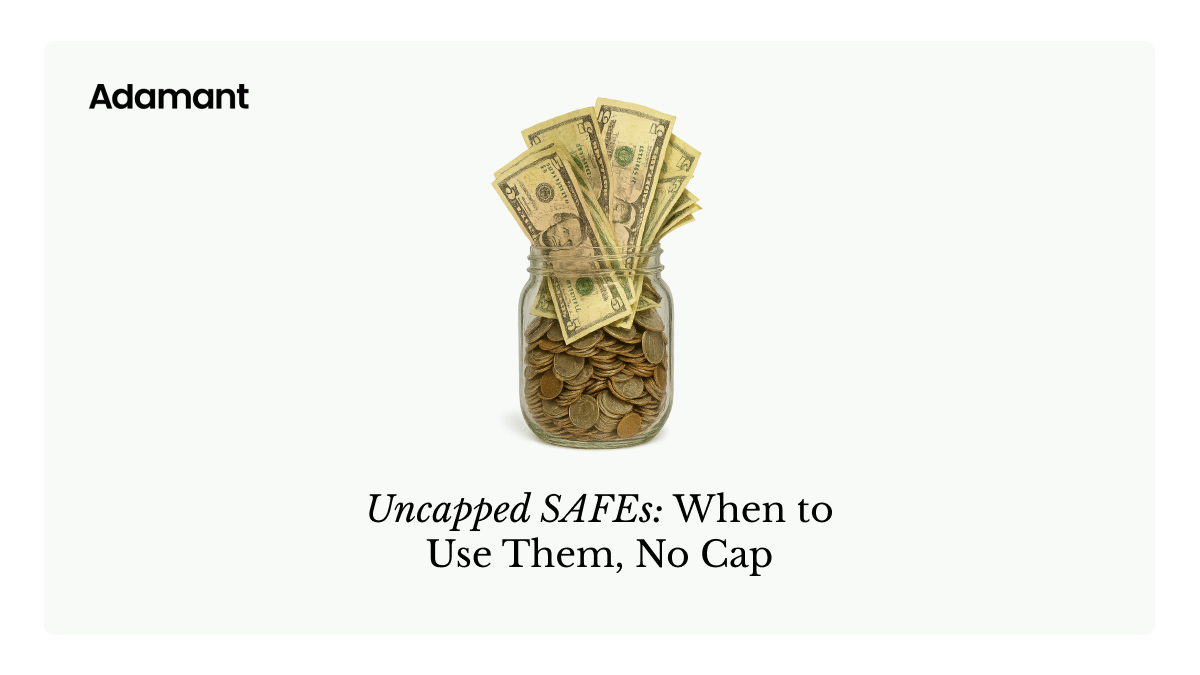Uncapped SAFEs Explained: When Founders Should (and Shouldn’t) Use Them

A founder asked me the other day “are there any problems with uncapped SAFEs?”
Answer:
Yes — there absolutely are. While uncapped SAFEs can seem founder-friendly, they carry serious trade-offs and risks for investors. The short answer is yes, there are problems, but understanding why requires some nuance.
That’s exactly what we’ll unpack here.
First — what’s a SAFE?
A SAFE (Simple Agreement for Future Equity) lets startups raise money quickly without the full legal and financial structure of an equity round.
When investors fund through a SAFE, they don’t own equity yet. Instead, their investment converts into equity later — when a future priced round happens.
The conversion terms usually depend on two variables:
- Valuation Cap: the maximum valuation at which the SAFE will convert.
- Discount: a percentage reduction on the next round’s valuation.
These two protect investors whether your company’s value rises or falls.
The valuation cap and discount are there to address two scenarios:
- Company value goes up
→ The valuation cap defines the highest price used to calculate how much equity investors get. If your company’s value soars, investors still convert as if your company were worth the capped amount (e.g., $10M). - Company value goes down
→ The discount gives investors a lower entry price. If you raise the next round below the cap, they convert at that lower price minus the agreed-upon discount.
For example:
If your SAFE had a $10M valuation cap and a 20% discount, and your next round is at $5M, investors would convert as if your company were valued at $4M (20% lower than $5M).
FUN FACT
For the past five years, the discount term was mostly symbolic — it rarely triggered, since companies either went up in value or died.
Now, with inflated valuation caps from the last funding boom, we’re about to see discounts finally matter. Many startups will raise future rounds below their previous SAFE caps.
Again…what is an uncapped SAFE??
Answer:
An uncapped SAFE removes the valuation cap entirely. The conversion price is determined only by the discount — no matter how much your valuation increases.
That means investors always convert at a fixed discount to the next round’s price, no cap 🚫🧢. If your company jumps from $10M to $100M in value, they still only get, say, 20% off that new valuation.
Why uncapped SAFEs?
Answer:
Founders use uncapped SAFEs to skip valuation debates and move fast. It avoids setting a specific number and keeps negotiations simple — but it can significantly disadvantage investors.
Founder benefits:
- Avoids time-consuming valuation talks.
- Keeps early fundraising private.
- Offers huge upside if valuation skyrockets — since investor equity stays minimal.
Example:
If your startup is worth ~$10M now but raises at $100M later, a 20% discount means those early investors convert at $80M, not $10M. You gave away far less equity. Great for you — brutal for them.
That’s exactly why seasoned investors hate uncapped SAFEs. Many got burned early on when companies exploded in value after they invested uncapped. It’s a painful lesson that made “never again” a rule for many.
Wait, so never uncapped SAFEs?
Answer:
Not never, but almost never. There are a few rare, short-term scenarios where they make sense for both sides.
Use an uncapped SAFE only when:
- The investment happens just before a priced equity round.
- Both founder and investor agree the round will happen soon.
- The investor feels confident they’ll be fairly compensated by the discount alone.
If the round is imminent, investors don’t risk missing out on a big valuation jump. But outside that context, an uncapped SAFE usually creates misaligned incentives.
Alternatives to uncapped SAFEs
Answer:
Don’t be lazy — there’s almost always a fair middle ground.
Set a cap.
Even if the number feels high, it gives investors confidence and keeps your reputation clean. Negotiation takes effort, but with some prep and awareness of market norms, you can bridge that gap.
Remember: investors do this all the time, so they’re better at it. But founders can close the gap with:
- Research into current valuation trends.
- Coaching or advice from experienced operators.
- Willingness to be transparent and fair.
The best approach? Set a cap — no cap. (Pun intended.)
Key Takeaways
- An uncapped SAFE removes the valuation ceiling; only a discount determines conversion.
- It heavily favors founders and limits investor upside.
- It’s reasonable only immediately before a priced round.
- A capped SAFE is usually better for fairness and long-term trust.
- Negotiate transparently — it pays off later.
FAQs
Q: What’s the main risk of an uncapped SAFE?
A: It can massively dilute investor returns if your valuation increases before the next round.
Q: When can an uncapped SAFE be acceptable?
A: When the equity round is already planned and expected soon.
Q: What’s a better alternative?
A: A capped SAFE or convertible note that balances both discount and cap.
Q: Why do investors dislike them so much?
A: They’ve been burned before — uncapped deals can turn a 20x return into a 3x one.



.jpg)